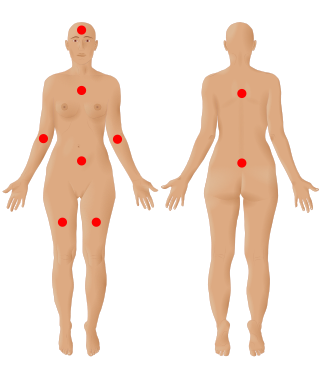Related Research Articles

A placebo can be roughly defined as a sham medical treatment. Common placebos include inert tablets, inert injections, sham surgery, and other procedures.

Fibromyalgia is a medical condition which causes chronic widespread pain, accompanied by fatigue, waking unrefreshed and cognitive symptoms. Other symptoms include headaches, lower abdominal pain or cramps, and depression. People with fibromyalgia can also experience insomnia and a general hypersensitivity.
An adverse effect is an undesired harmful effect resulting from a medication or other intervention, such as surgery. An adverse effect may be termed a "side effect", when judged to be secondary to a main or therapeutic effect. The term complication is similar to adverse effect, but the latter is typically used in pharmacological contexts, or when the negative effect is expected or common. If the negative effect results from an unsuitable or incorrect dosage or procedure, this is called a medical error and not an adverse effect. Adverse effects are sometimes referred to as "iatrogenic" because they are generated by a physician/treatment. Some adverse effects occur only when starting, increasing or discontinuing a treatment. Using a drug or other medical intervention which is contraindicated may increase the risk of adverse effects. Adverse effects may cause complications of a disease or procedure and negatively affect its prognosis. They may also lead to non-compliance with a treatment regimen. Adverse effects of medical treatment resulted in 142,000 deaths in 2013 up from 94,000 deaths in 1990 globally.
The medical history, case history, or anamnesis of a patient is a set of information the physicians collect over medical interviews. It involves the patient, and eventually people close to them, so to collect reliable/objective information for managing the medical diagnosis and proposing efficient medical treatments. The medically relevant complaints reported by the patient or others familiar with the patient are referred to as symptoms, in contrast with clinical signs, which are ascertained by direct examination on the part of medical personnel. Most health encounters will result in some form of history being taken. Medical histories vary in their depth and focus. For example, an ambulance paramedic would typically limit their history to important details, such as name, history of presenting complaint, allergies, etc. In contrast, a psychiatric history is frequently lengthy and in depth, as many details about the patient's life are relevant to formulating a management plan for a psychiatric illness.
Clinical endpoints or clinical outcomes are outcome measures referring to occurrence of disease, symptom, sign or laboratory abnormality constituting a target outcome in clinical research trials. The term may also refer to any disease or sign that strongly motivates withdrawal of an individual or entity from the trial, then often termed a humane (clinical) endpoint.
A pain scale measures a patient's pain intensity or other features. Pain scales are a common communication tool in medical contexts, and are used in a variety of medical settings. Pain scales are a necessity to assist with better assessment of pain and patient screening. Pain measurements help determine the severity, type, and duration of the pain, and are used to make an accurate diagnosis, determine a treatment plan, and evaluate the effectiveness of treatment. Pain scales are based on trust, cartoons (behavioral), or imaginary data, and are available for neonates, infants, children, adolescents, adults, seniors, and persons whose communication is impaired. Pain assessments are often regarded as "the 5th vital sign".
Interferon beta-1b is a cytokine in the interferon family used to treat the relapsing-remitting and secondary-progressive forms of multiple sclerosis (MS). It is approved for use after the first MS event. Closely related is interferon beta 1a, also indicated for MS, with a very similar drug profile.
In medicine, patient compliance describes the degree to which a patient correctly follows medical advice. Most commonly, it refers to medication or drug compliance, but it can also apply to other situations such as medical device use, self care, self-directed exercises, or therapy sessions. Both patient and health-care provider affect compliance, and a positive physician-patient relationship is the most important factor in improving compliance. Access to care plays a role in patient adherence, whereby greater wait times to access care contributing to greater absenteeism. The cost of prescription medication also plays a major role.
Pharmacotherapy, also known as pharmacological therapy or drug therapy, is defined as medical treatment that utilizes one or more pharmaceutical drugs to improve ongoing symptoms, treat the underlying condition, or act as a prevention for other diseases (prophylaxis).
A case report form is a paper or electronic questionnaire specifically used in clinical trial research. The case report form is the tool used by the sponsor of the clinical trial to collect data from each participating patient. All data on each patient participating in a clinical trial are held and/or documented in the CRF, including adverse events.
A patient-reported outcome (PRO) is a health outcome directly reported by the patient who experienced it. It stands in contrast to an outcome reported by someone else, such as a physician-reported outcome, a nurse-reported outcome, and so on. PRO methods, such as questionnaires, are used in clinical trials or other clinical settings, to help better understand a treatment's efficacy or effectiveness. The use of digitized PROs, or electronic patient-reported outcomes (ePROs), is on the rise in today's health research setting.

PatientsLikeMe (PLM) is an integrated community, health management, and real-world data platform. The platform currently has over 830,000 members who are dealing with more than 2,900 conditions, such as ALS, MS, and epilepsy. Data generated by patients themselves are collected and quantified with the goal of providing an environment for peer support and learning. These data capture the influences of different lifestyle choices, socio-demographics, conditions and treatments on a person's health.
The experience sampling method (ESM), also referred to as a daily diary method, or ecological momentary assessment (EMA), is an intensive longitudinal research methodology that involves asking participants to report on their thoughts, feelings, behaviors, and/or environment on multiple occasions over time. Participants report on their thoughts, feelings, behaviors, and/or environment in the moment or shortly thereafter. Participants can be given a journal with many identical pages. Each page can have a psychometric scale, open-ended questions, or anything else used to assess their condition in that place and time. ESM studies can also operate fully automatized on portable electronic devices or via the internet. The experience sampling method was developed by Suzanne Prescott during doctoral work at University of Chicago's Committee on Human Development with assistance from her dissertation advisor Mihaly Csikszentmihalyi. Early studies that used ESM were coauthored by fellow students Reed W. Larson and Ronald Graef, whose dissertations both used the method.
A glossary of terms used in clinical research.

In general, quality of life is the perceived quality of an individual's daily life, that is, an assessment of their well-being or lack thereof. This includes all emotional, social and physical aspects of the individual's life. In health care, health-related quality of life (HRQoL) is an assessment of how the individual's well-being may be affected over time by a disease, disability or disorder.
Neonatal withdrawal or neonatal abstinence syndrome (NAS) or neonatal opioid withdrawal syndrome (NOWS) is a withdrawal syndrome of infants after birth caused by in utero exposure to drugs of dependence, most commonly opioids. Common signs and symptoms include tremors, irritability, vomiting, diarrhea, and fever. NAS is primarily diagnosed with a detailed medication history and scoring systems. First-line treatment should begin with non-medication interventions to support neonate growth, though medication interventions may be used in certain situations.
An electronic patient-reported outcome (ePRO) is a patient-reported outcome that is collected by electronic methods. ePRO methods are most commonly used in clinical trials, but they are also used elsewhere in health care. As a function of the regulatory process, a majority of ePRO questionnaires undergo the linguistic validation process. When the data is captured for a clinical trial, the data is considered a form of Electronic Source Data.
Sarilumab, sold under the brand name Kevzara, is a human monoclonal antibody medication against the interleukin-6 receptor. Regeneron Pharmaceuticals and Sanofi developed the drug for the treatment of rheumatoid arthritis (RA), for which it received US FDA approval on 22 May 2017 and European Medicines Agency approval on 23 June 2017.

Deprescribing is a process to taper or stop medications with the intention to achieve improved health outcomes by reducing exposure to medications that are potentially either harmful or no longer required. Deprescribing is important to consider with changing health and care goals over time, as well as polypharmacy and adverse effects. Deprescribing can improve adherence, cost, and health outcomes but may have adverse drug withdrawal effects. More specifically, deprescribing is the planned and supervised process of intentionally stopping a medication or reducing its dose to improve the person's health or reduce the risk of adverse side effects. Deprescribing is usually done because the drug may be causing harm, may no longer be helping the patient, or may be inappropriate for the individual patient's current situation. Deprescribing can help correct polypharmacy and prescription cascade.
Golodirsen, sold under the brand name Vyondys 53, is a medication used for the treatment of Duchenne muscular dystrophy (DMD). It is an antisense oligonucleotide drug of phosphorodiamidate morpholino oligomer (PMO) chemistry.
References
- Stone AA, Broderick JE, Shiffman SS, Schwartz JE. Understanding recall of weekly pain from a momentary assessment perspective: absolute agreement, between- and within-person consistency, and judged change in weekly pain, Pain, 2004;107 (1-2): 61-69
- Tiplady B, Crompton GK, Brackenridge D. Electronic diaries for asthma, British Medical Journal, 1995; 310: 1469
- van Berge Henegouwen MT, van Driel HF, Kasteleijn-Nolst Trenite DG., A patient diary as a tool to improve medicine compliance, Pharm World Sci. 1999 Feb;21(1):21-4.
- van Gerven JM, Schoemaker RC, Jacobs LD, Reints A, Ouwersloot-van der Meij MJ, Hoedemaker HG, Cohen AF., Self-medication of a single headache episode with ketoprofen, ibuprofen or placebo, home-monitored with an electronic patient diary, Br J Clin Pharmacol. 1996 Oct;42(4):475-81.